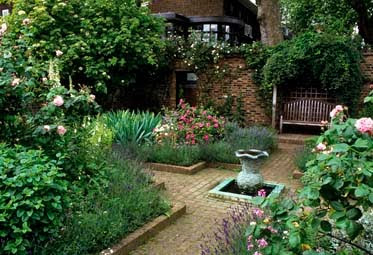
Herb gardening is undertaken by both the urban dweller with room sufficient only for a windowsill planter... to the gardener who has both the time and land for more ambitious endeavors.
There are quite a few options we are going to explore if you are up to the challenge of devoting time to maintaining a larger herb garden design.
For example, the formal garden which has its roots in classical design and architecture first arose to prominence as the embodiment of our supremacy over nature by bending and sculpting horticulture into balanced designs.
Your formal garden concept should be a well-balanced thought out design with herbs intermixed among shrubs, flowers and trees. Typically a formal garden will be the focus viewed from key windows of the home. The herb garden contributes to the look of the garden but serves a different function.
Decorative paving and/or sculptures add extra splendor to the use of your formal herb garden design. Some of the most vivid examples of these types of gardens can be found in European gardens where they were first cultivated.
Varying heights of hedges is one of the key features in a formal garden. However it must be balanced proportionately with attention to angles that employ a variety of shapes such as ovals, ellipses, squares and other non-traditional shapes.
Another great herb garden design is the color themed garden. This is an artistic way to give your garden an explosion of color. Some theme gardens concentrate solely on single shades while others are a riotous cornucopia of bold colors.
Ground cover herbs are ideal for use in themed gardens as well. These low growing plants provide texture to the landscape and fills in gaps or hard to plant areas that need more color and volume. And for those singular spots such along stone steps, in-between flagstone or at the base of trees, ground cover herbs fit the bill.
Some of the best choices of flowering herbs are the common lady's mantle, soapwort, roman chamomile, creeping golden marjoram, Aztec sweet herb, bee balm, and lavender.
Do not over think your color themed garden. Keep in mind that some of the most splendid concepts are those that rely on atypical groupings of color.
Your last consideration is planting herbs as companion plants. These are herbs planted in flower and vegetable gardens where each plant benefits from the presence of the other.
Case in point, garlic deters a variety of garden pests and assists with the flowering of other plants. Basil entices bees which in turn pollinate tomatoes. Chives which are usually grown in a border area to help arrest black spot which is a very common disease which attacks roses in particular.
Many herbs such as yarrow, coriander, dill and rosemary provide welcoming terrain for helpful insects both parasitic and predatory that assist in keeping others of the pest population within control.
Herb garden designs are only limited by your imagination. If you can conceive it and it fits your needs, there are no restrictions. Sometimes experimentation is needed to create an herb garden that fits your specific needs.
Joel & Ara'Bella are herbal experts. For more information on herb garden design visit http://www.herbgardeningcare.com/.
